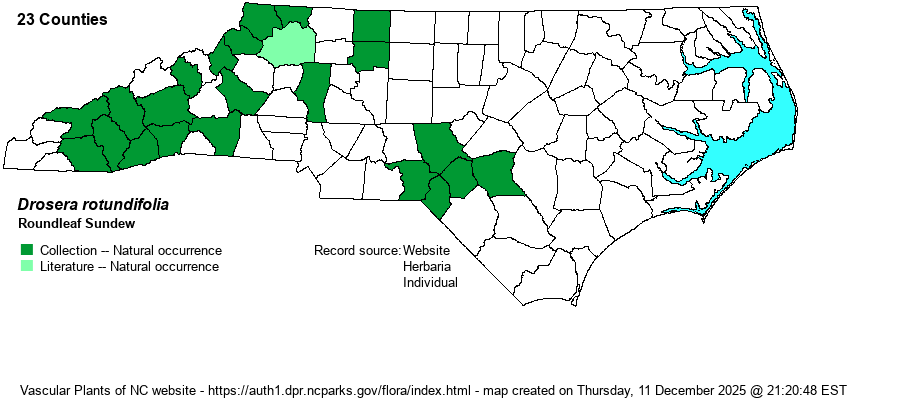| Author | L. | |
| Distribution | The only sundew that grows in the NC Mountains, it is found essentially throughout that province, and sparingly into the western Piedmont east to Stokes, Forsyth, and Iredell counties. It is disjunct eastward to the Sandhills region, where known from nearly all counties there but very sparse.
This is a sundew of the Far North, ranging from coast to coast across all of Canada and then south to PA, the southern end of the Great Lakes, and central CA. South of PA it is found mainly in the Appalachians to northeastern GA, though there are scattered locations east of the Mountains across VA and the NC Sandhills. | |
| Abundance | Uncommon to infrequent in the Mountains; very rare in the western Piedmont. Rare in the Sandhills, where caution is urged in identification vis-a-vis D. capillaris. | |
| Habitat | This species is usually found in montane bogs and fens, but it can occur in seepage slopes, including on steep rocky areas with seepage. In the Sandhills it is found in Sandhill seeps and streamhead pocosin margins. Weakley (2018) mentions that it also occurs in vertical seepage areas on the clay banks of the Little River, near the northeastern edge of the Sandhills. |
| Phenology | This species blooms in mid- to late summer, from July to September; it fruits shortly after flowering. | |
| Identification | This sundew is obviously unique and easy to identify of the plants in the NC mountains, but it is rather similar to several other mostly Coastal Plain sundews. It has a rosette of 10 or more leaves that spread horizontally or diagonally from a central node; the rosette averages about 2-2.5 inches across, rarely to 3 inches across. It is not as strictly "ground-hugging" as are D. brevifolia and D. capillaris. Unlike with those, the slender petiole ends abruptly at the blade; each petiole averages 1-1.5 inches long. The wide blade is strongly beset in long sticky glands as in other sundews. The glabrous flowering stem or stems grow far above the leaves, to about 5 inches tall; the flowers (arranged in a spike) are normally white or at times tinged with pink, and about 1/3-inch across. It can easily be confused with D. capillaris in the Sandhills, or at least passed over and assumed to be D. capillaris in that region (as the latter is much more common). However, D. capillaris usually has pink flowers, normally grows flatter to the ground, but also it has leaf blades distinctly longer than wide. Young plants of D. intermedia also have long and quite narrow petioles, but that species has the leaf blades in an elliptical shape (i.e., longer than wide). D. brevifolia has leaves that are wedge-shaped, with the petiole expanded outward into the blade, with little distinction between the two. It is the blade shape that references tend to highlight as the chief separation between D. rotundifolia and the others. Normally, when one is working in bogs in the mountains, he or she is looking for rarer plants, but a consequence of such searching is often running into D. rotundifolia, still a nice find. | |
| Taxonomic Comments | Remarkably, despite its huge range, Weakley (2018) and many other references do not list any varieties or subspecies.
| |
| Other Common Name(s) | Common Sundew | |
| State Rank | S3 | |
| Global Rank | G5 | |
| State Status | | |
| US Status | | |
| USACE-agcp | OBL link |
| USACE-emp | OBL link |

